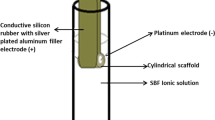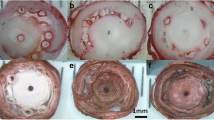Abstract
Successful long term bone replacement and repair remain a challenge today. Nanotechnology has made it possible to alter materials’ characteristics and therefore possibly improve on the material itself. In this study, biphasic hydroxyapatite/β-tricalcium phosphate nanobioceramic scaffolds were prepared by the electrospinning technique in order to mimic the extracellular matrix. Scaffolds were characterised by scanning electron microscopy (SEM) and attenuated total reflectance–fourier transform infrared. Osteoblasts as well as monocytes that were differentiated into osteoclast-like cells, were cultured separately on the biphasic bioceramic scaffolds for up to 6 days and the proliferation, adhesion and cellular response were determined using lactate dehydrogenase cytotoxicity assay, nucleus and cytoskeleton dynamics, analysis of the cell cycle progression, measurement of the mitochondrial membrane potential and the detection of phosphatidylserine expression. SEM analysis of the biphasic bioceramic scaffolds revealed nanofibers spun in a mesh-like scaffold. Results indicate that the biphasic bioceramic electrospun scaffolds are biocompatible and have no significant negative effects on either osteoblasts or osteoclast-like cells in vitro.










Similar content being viewed by others
References
Heinemann S, Heinemann C, Bernhardt R, Reinstorf A, Nies B, Meyer M, Worch H, et al. Bioactive silica–collagen composite xerogels modified by calcium phosphate phases with adjustable mechanical properties for bone replacement. Acta Biomater. 2009;5:1979–90.
Schilling AF, Linhart W, Filke S, Gebauer M, Schinke T, Rueger JM, Amling M. Resorbability of bone substitute biomaterials by human osteoclasts. Biomaterials. 2004;25:3963–72.
Heness G, Ben-Nissan B. Innovative bioceramics. Mater Forum. 2004;27:104–14.
Pan H, Zhao X, Darvell BW, Lu WW. Apatite-formation ability—predictor of “bioactivity”? Acta Biomater. 2010;6:4181–8.
Armentano I, Dottori M, Fortunati E, Mattioli S, Kenny JM. Biodegradable polymer matrix nanocomposites for tissue engineering: a review. Polym Degrad Stab. 2010;95:2126–46.
Dorozhkin SV. Bioceramics of calcium orthophosphates. Biomaterials. 2010;31:1465–85.
Chevalier J, Gremillard L. Ceramics for medical applications: a picture for the next 20 years. J Eur Ceram Soc. 2009;29:1245–55.
Dorozhkin SV. Bioceramics based on calcium orthophosphates (Review). Glass and Ceram. 2007;64:442–7.
Sergey VD. Biphasic, triphasic and multiphasic calcium orthophosphates. Acta Biomater. 2012;8:963–77.
Von der Mark K, Park J, Schmuki P. Nanoscale engineering of biomimetic surfaces: cues from the extracellular matrix. Cell Tissue Res. 2010;339:131–53.
Holzwarth JM, Ma PX. Biomimetic nanofibrous scaffolds for bone tissue engineering. Biomaterials. 2011;32:9622–9.
Wei J, Jia J, Wu F, Wei S, Zhou H, Zhang H, Shin J, et al. Hierarchically microporous/macroporous scaffold of magnesium–calcium phosphate for bone tissue regeneration. Biomaterials. 2010;31:1260–9.
Dorozhkin SV. Nanosized and nanocrystalline calcium orthophosphates. Acta Biomater. 2010;6:715–34.
Hieu LC, Quoc LH, Thanh VV, Nguyen TD, An PV, Hung LT, Khanh L. Current medical product development for diagnosis, surgical planning and treatment in the areas of Neurosurgery, Orthopeadic and Dental-Cranio-Maxillofacial surgery in Vietnam. IFMBE Proc 2010;27:123–126.
Patterson J, Martino MM, Hubbell JA. Biomimetic materials in tissue engineering. Mater Today. 2010;13:14–22.
Vallet-Regí M. Evolution of bioceramics within the field of biomaterials. C R Chim. 2010;13:174–85.
Hench LL, Thompson I. Twenty-first century challenges for biomaterials. J R Soc Interface. 2010;7:S379–91.
Schilling AF, Filke S, Brink S, Korbmacher H, Amling M, Rueger JM. Osteoclasts and biomaterials. Eur J Trauma. 2006;32:107–13.
Jones JR. New trends in bioactive scaffolds: the importance of nanostructure. J Eur Ceram Soc. 2009;29:1275–81.
Athanasou NA. The osteoclast-what’s new? Skelet Radiol. 2011;40:1137–40.
Bohner M. Resorbable biomaterials as bone graft substitutes. Mater Today. 2010;13:24–30.
Costa-Rodrigues J, Fernandes A, Lopes MA, Fernandes MH. Hydroxyapatite surface roughness: complex modulation of the osteoclastogenesis of human precursor cells. Acta Biomater. 2012;8:1137–45.
Albrektsson T, Johansson C. Osteoinduction, osteoconduction and osseointegration. Eur Spine J. 2002;10:S96–101.
Habibovic P, Gbureck U, Doillon CJ, Bassett DC, van Blitterswijk CA, Barralet JE. Osteoconduction and osteoinduction of low-temperature 3D printed bioceramic implants. Biomaterials. 2008;29:944–53.
Yuan H, Kurashina K, de Bruijn JD, Li Y, de Groot K, Zhang X. A preliminary study on osteoinduction of two kinds of calcium phosphate ceramics. Biomaterials. 1999;20:1799–806.
Ripamonti U, Roden LC, Renton LF. Osteoinductive hydroxyapatite-coated titanium implants. Biomaterials. 2012;33:3813–23.
Ripamonti U, Crooks J, Khoali L, Roden L. The induction of bone formation by coral-derived calcium carbonate/hydroxyapatite constructs. Biomaterials. 2009;30:1428–39.
Ripamonti U, Richter PW, Nilen RWN, Renton L. The induction of bone formation by smart biphasic hydroxyapatite tricalcium phosphate biomimetic matrices in the non-human primate Papio ursinus. J Cell Mol Med. 2008;12:1–15.
Bhardwaj N, Kundu SC. Electrospinning: a fascinating fiber fabrication technique. Biotechnol Adv. 2010;28:325–47.
Franco PQ, João CFC, Silva JC, Borges JP. Electrospun hydroxyapatite fibers from a simple sol–gel system. Mater Lett. 2012;67:233–6.
Dubben S, Honscheid A, Winkler K, Rink L, Haase H. Cellular zinc homeostasis is a regulator in monocyte differentiation of HL-60 cells by 1{alpha},25-dihydroxyvitamin D3. J Leukoc Biol. 2010;87(5):833–44.
Soares-Schanoski A, Gomez-Pina V, del Fresno C, Rodriguez-Rojas A, Garcia F, Glaria A, Sanchez M, et al. 6-Methylprednisolone down-regulates IRAK-M in human and murine osteoclasts and boosts bone-resorbing activity: a putative mechanism for corticoid-induced osteoporosis. J Leukoc Biol. 2007;82:700–9.
Kondo N, Tokunaga K, Ito T, Arai K, Amizuka N, Minqi L, Kitahara H, et al. High dose glucocorticoid hampers bone formation and resorption after bone marrow ablation in rat. Microsc Res Tech. 2006;69:839–46.
Xu JL, Khor KA, Sui JJ, Zhang JH, Chen WN. Protein expression profiles in osteoblasts in response to differentially shaped hydroxyapatite nanoparticles. Biomaterials. 2009;30:5385–91.
Alcaide M, Serrano MC, Pagani R, Sanchez-Salcedo S, Nieto A, Vallet-Regi M, Portoles MT. L929 fibroblast and Saos-2 osteoblast response to hydroxyapatite-betaTCP/agarose biomaterial. J Biomed Mater Res A. 2009;89:539–49.
Alcaide M, Serrano M, Pagani R, Sánchez-Salcedo S, Vallet-Regí M, Portolés M. Biocompatibility markers for the study of interactions between osteoblasts and composite biomaterials. Biomaterials. 2009;30:45–51.
Galluzzi L, Zamzami N, de La Motte Rouge T, Lemaire C, Brenner C, Kroemer G. Methods for the assessment of mitochondrial membrane permeabilization in apoptosis. Apoptosis. 2007;12:803–13.
Li X, Nan K, Shi S, Chen H. Preparation and characterization of nano-hydroxyapatite/chitosan cross-linking composite membrane intended for tissue engineering. Int J Biol Macromol. 2012;50:43–9.
Kailasanathan C, Selvakumar N, Naidu V. Structure and properties of titania reinforced nano-hydroxyapatite/gelatin bio-composites for bone graft materials. Ceram Int. 2012;38:571–9.
Zhang X, Cai Q, Liu H, Zhang S, Wei Y, Yang X, Lin Y, et al. Calcium ion release and osteoblastic behavior of gelatin/beta-tricalcium phosphate composite nanofibers fabricated by electrospinning. Mater Lett. 2012;73:172–5.
Venugopal J, Low S, Choon AT, Sampath Kumar TS, Ramakrishna S. Mineralization of osteoblasts with electrospun collagen/hydroxyapatite nanofibers. J Mater Sci Mater Med. 2008;19:2039–46.
Hilal Turkoglu S. Novel hybrid scaffolds for the cultivation of osteoblast cells. Int J Biol Macromol. 2011;49:838–46.
Acknowledgments
This study was financially supported by the Council for Scientific and Industrial Research (CSIR), Pretoria, South Africa. SEM analysis was performed at The National Centre for Nano-Structured Materials, CSIR, Pretoria, South Africa. Flow cytometric analysis was conducted at the Department of Pharmacology, Faculty of Health Sciences, University of Pretoria, Pretoria, South Africa. Special thanks to the people working in Prof. A. Joubert’s Laboratory, Department of Physiology, Faculty of Health Sciences, University of Pretoria, Pretoria, South Africa for support.
Author information
Authors and Affiliations
Corresponding author
Rights and permissions
About this article
Cite this article
Wepener, I., Richter, W., van Papendorp, D. et al. In vitro osteoclast-like and osteoblast cells’ response to electrospun calcium phosphate biphasic candidate scaffolds for bone tissue engineering. J Mater Sci: Mater Med 23, 3029–3040 (2012). https://doi.org/10.1007/s10856-012-4751-y
Received:
Accepted:
Published:
Issue Date:
DOI: https://doi.org/10.1007/s10856-012-4751-y




